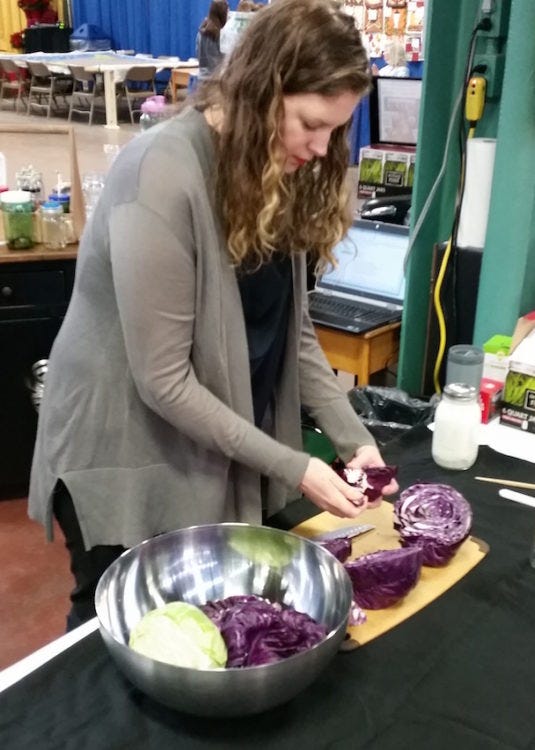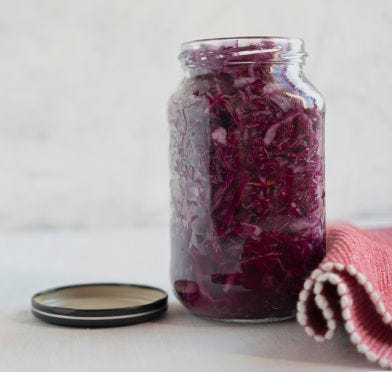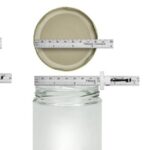
The Simplest Sauerkraut
Updated – March 2, 2021
Homemade sauerkraut is wonderfully different from the kraut you get at the grocery store. It has a nice crunch, is perfectly sour, and pairs well with a pork roast.
Sauerkraut is often one of the first fermentation projects recommended for newbies. Mainly because it is very easy to make, and the results are pretty delicious! Amanda Feifer, the author of the book Ferment Your Vegetables, and the blog Phickle.com demonstrated how to make this recipe, and lucky us… we went home with a jar!
 Simplest Sauerkraut
Simplest Sauerkraut
2 pounds (900 g) cabbage (we used red cabbage)
4 teaspoons (22 g) kosher salt
1 wide mouth quart jar
Core cabbage and remove any unattractive or wilted outer leaves. Reserve one cabbage leaf, compost the rest.
Shred cabbage into 1/4 inch strips using a sharp chef’s knife, the slicer blade of your food processor, a mandoline, or a kraut shredder.
Place shredded cabbage into a large bowl, add salt and toss thoroughly for about 30 seconds or until the cabbage has a sheen of moisture on it. The salt has successfully drawn some water from the cabbage.
You now have the option of continuing to gently massage and squeeze the cabbage or letting the salt and cabbage continue osmosis while you go do something else for 20 minutes. If you let them sit a bit, the work of kneading the cabbage to release as much water as possible will be easier when you return.
Work/knead the cabbage for a few more minutes. When there is a visible puddle of water in the bottom of the bowl and the cabbage pieces stay in a loose clump when squeezed, you are ready to start packing your jar.
Take a handful of cabbage and using a clean, quart-size jar, press the cabbage into the bottom of the jar, and pack it along the bottom, with the top of your fist or your fingers. Continue packing in this fashion, pressing along the sides and bottom, until it comes to about 1 inch below the jar rim. Press down firmly to release juices and eliminate air pockets. A Pickle Packer is a handy tool to help pack jars.

Place the reserved cabbage leaf on top of the kraut and, with clean hands, press the sides of the leaf around the sides of the shredded cabbage, creating a surface barrier. Place the jar lid loosely on, but don’t tighten completely. If you’re nervous about not using any special fermenting tools, give these Pickle Pipes, or Pickle Pebbles a try.
Allow to ferment at room temperature for 2 to 6 weeks, depending on the warmth of your home and your taste preferences. Keep the cabbage submerged in the brine at all times to keep oxygen out and prevent mold growth. Check weekly to make sure that the brine level is still above the top of the cabbage. If it isn’t, press down on the top cabbage leaf to get the brine to rise back above. If the brine is severely depleted, you may want to add more brine, at a concentration of about 5% by weight, but there shouldn’t be a need to do this.
Once the taste is sour enough for your preference, remove the leaf or weight, secure the jar lid, and place the jar in the fridge.
This yields one quart of sauerkraut but can easily be scaled for larger quantities.
Kraut in Action
We let our kraut ferment for about 6 weeks. We used our homemade kraut in a pork and sauerkraut crockpot recipe. Instead of using apple and brown sugar in our pork and kraut recipe, we used apple butter.
If you need any fermenting supplies we’ve got you covered. Check out our fermenting tools here.







Are you adding beets (shredded or sliced) to obtain the reddish color in your kraut? Or is the color the result of using purple cabbage in your recipe?
My Mom used to make it with a little shredded raw peeled beet added to make the the kraut pinkish…
When Amanda was fermenting with us at the Farm Show, we used the purple cabbage – which gave us a nice pink/mauve kraut. I’d suggest checking her site – Phickle – as she may have a recipe that incorporates beet.
Is there a difference in the taste when using purple cabbage? I have always just used green cabbage.
Both purple and green cabbage taste great as a sauerkraut.
A cabbage crusher is a great tool to both work the cabbage and to tamp it into a jar for fermenting. Here in Lancaster County, you can find them large and small at flea markets and mud sales. It is a great gadget for anyone making sauerkraut.
How long will this keep in refrigerator after it is opened? Ballpark figure.
Fully fermented kraut may be kept tightly covered in the refrigerator for several months. Do not eat/taste if you see mold on the surface, feel a slimy texture, or smell a bad odor. Be safe and just discard it.
Your recipe doesn’t mention the brine until the very end so it is a bit confusing as to where the brine comes from.
Hi Paul,
Sorry to confuse you. The brine is actually created when the salt begins to draw water from the cabbage.